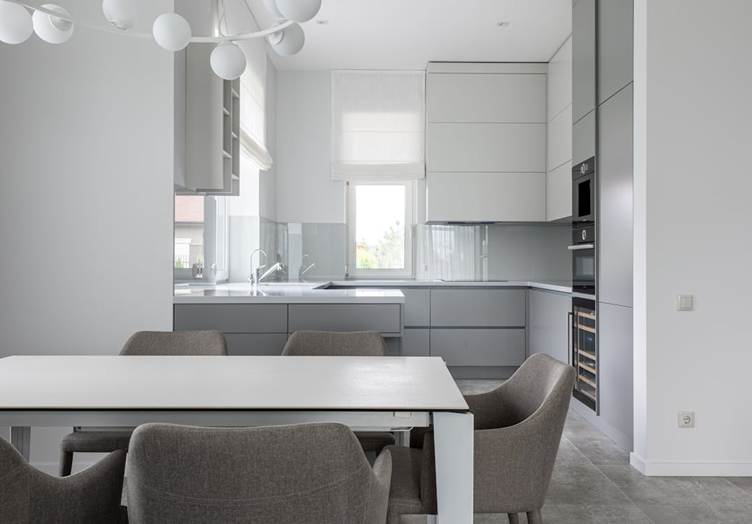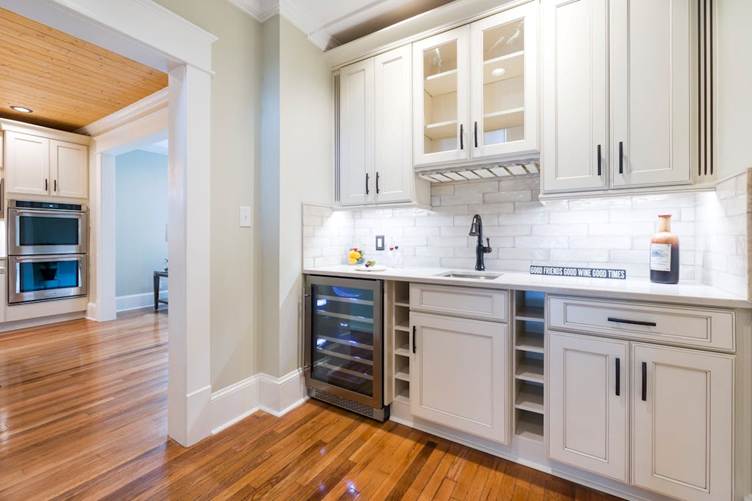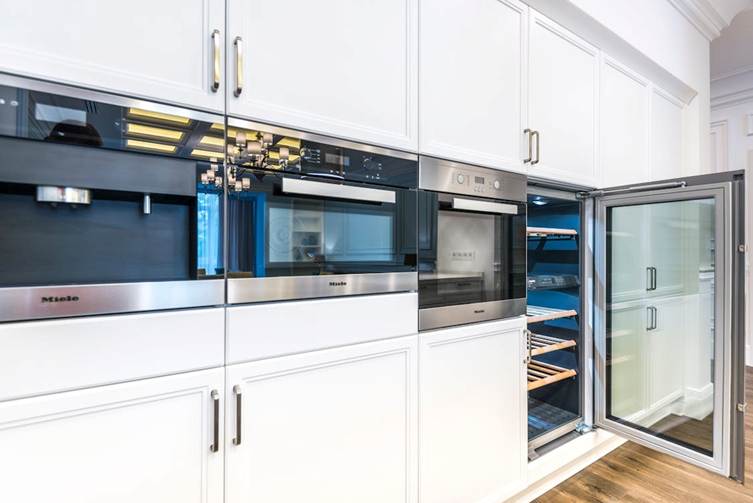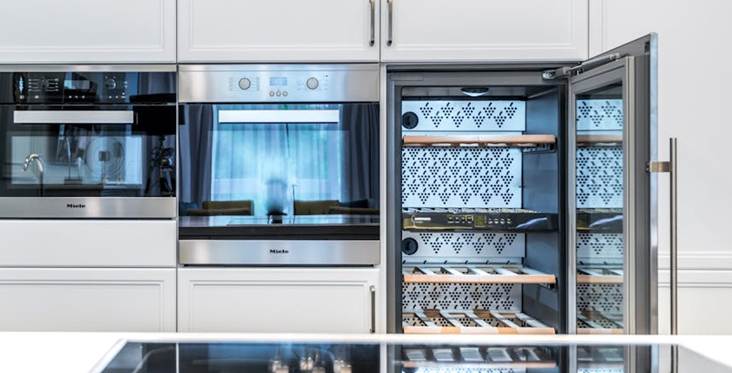Ever opened a cabinet and found last summer’s rosé sweating next to the soy sauce?
You’re not alone.
Most wine lovers – even serious ones – begin with good intentions: store wine somewhere dark, cool, and undisturbed. But let’s be honest. Life happens. A half-bottle of Barolo ends up vertical on a pantry shelf next to a garlic press, and before you know it, your collection is aging like unrefrigerated shrimp. It’s fine. No judgment. But that’s exactly why we’re here.
Because there’s something intensely satisfying – almost spiritual – about opening your kitchen wine fridge and seeing your favourites lined up like VIPs at a private tasting. Controlled. Cool. Ready. Like your own little Louvre of vinification.
Let’s talk about how to make that magic happen – without wasting money, space, or your wine’s potential.
Design Around the Details: Built-In vs. Freestanding vs. Fully Integrated

All kitchen wine fridges are not created equal – especially when it comes to fitting flush with your cabinetry.
Some units live quietly under your countertop. Others scream “look at me” like a Versace coffee table. Neither is wrong. But mismatching the fridge to your kitchen plan? That’s how aesthetic heartbreak begins.
Quick breakdown:
- Built-in (front-venting): Flush with cabinets. Typically, 15–24” wide. Best for clean lines and semi-permanent installs. Think Gwyneth at a tasting room in Napa.
- Freestanding: Wants breathing room. Needs 3” on the sides and back. Great for flexible spaces, but not for cramming into tight cabinetry. This is your Airbnb on the coast of Oregon solution.
- Fully integrated: Panel-ready, ghost-in-the-machine vibe. Disappears into your kitchen like a Noma course. But it’ll cost you. And your cabinet guy will need precise specs. Be sure to give him cookies.
Here’s a good comparison guide discussing these in more detail: Integrated vs Freestanding Wine Fridges
Don’t buy a fridge. Buy a fit. Like a tuxedo, it only looks amazing when tailored.
Prioritize This First: Decide Based on Bottle Capacity and Use-Case

No, 18 bottles aren’t always “enough.”
Before you do anything – before you fall in love with a brushed steel finish or a “whisper quiet” spec – count your bottles. No, seriously. Go count. Then add 30%.
Because here’s the trap: a fridge that fits your current collection won’t fit your future self. The one who discovers a Georgian orange wine and suddenly wants to keep six on hand. Or who gets a Wine Access shipment of grower Champagnes and can’t bear to open them just yet. Sound familiar?
Capacity-Based Tips:
- 6–18 bottles: Great for everyday drinkers, tight spaces, or one-glass-a-night folks. Usually, 15″ wide or narrower. (Think: the studio apartment version of wine storage.)
- 24–36 bottles: Ideal for weekend entertainers who stock up during Whole Foods runs and like variety. (You probably own more than one type of wine glass.)
- 45+ bottles: You’re either investing in wine or you’re ready to. Either way, you’re in the deep end. These are full-depth, 24” models that need some commitment – but deliver serenity. (They’re the Sade album of your kitchen appliances.)
Sidenote: Make sure you consider the size of bottle you plan on storing, as Bordeaux bottles aren’t the same size as champagne (but you know that already).
A wine fridge isn’t a trophy case. It’s a time machine for your taste. Give it room to work.
Don’t Just Cool – Preserve: Why Temperature Zones Change Everything

Single-zone units sound elegant – until you try chilling whites and aging reds in the same chamber. Spoiler alert: your Sancerre suffers.
You wouldn’t refrigerate both your sushi and your soup in the same compartment, right? Same idea here. Temperature affects flavour like pitch affects music. Get it wrong, and everything feels… off.
Enter: dual-zone fridges – the Beyoncé-level upgrade that changes everything. Suddenly, your Viognier lives at 47°F while your Barolo chills at a sultry 60°F. Harmony. Balance. A refrigerator with taste.
What to Look For:
- Independent controls, not a single toggle. If it doesn’t let you fine-tune to ±1°F, it’s guessing. You shouldn’t be.
- Fan-forced circulation, not passive cooling. That’s like choosing between central air and waving a paper plate.
- Memory recall – because the universe loves a power outage during your dinner party prep.
If your dinner party includes both oysters and osso buco – you need dual zones. It’s not luxury. It’s logistics.
Know Where to Buy: Trusted Retailers for Quiet, Durable Kitchen Models

If your fridge buzzes louder than your guests, it’s the wrong fridge (source).
Let’s be blunt: a lot of retailers sell wine fridges the way bookstores sell diet books – aspirational, aesthetic, and mostly unread. You need actual specs. Real engineering. Data. Ideally, from people who’ve installed these in actual homes – not just staged photo shoots.
We recommend buying an EWS Wine Fridge, as their range includes quiet models clocking in at 36–38dB (that’s library-silent), they are high-efficiency fridges under 90 kWh/year (about what a toaster uses in two months), and they offer deep category filters for important features (noise level, bottle shape, install type, and zone number).
Plus, some real-time support if your Champagne shelf won’t fit your Ruinart magnums.
Avoid Regret Later: Pay Attention to Shelving, Racking, and Ergonomics

What looks sleek online might stab you in the cuticles when pulling out a Bordeaux.
I wish that were an exaggeration.
Most wine fridges are designed for standard Bordeaux bottles. Not the bulbous Rhône beauties. Not the sloping-shouldered Burgundies. Not the Dom Pérignons of the world. And when shelves don’t glide properly, you’ll be doing the wine version of Jenga with a $200 Pinot. That’s not a game anyone wins.
Features worth your money:
- Smooth glide tracks with full extension. If you can’t reach the back row without scraping your knuckles, you’ve already lost.
- Adjustable shelf spacing – ideally 3.25” or more between levels. Measure your tallest bottle before you buy. Not after.
- Wooden shelves – because wood dampens vibration like a cello case and doesn’t clang like steel at midnight.
A friend – longtime collector, new parent – told me pulling wine from their fridge one-handed became a nightly juggling act until they swapped for full-extension rails. Their verdict? “The fridge became a joy instead of a task.” That’s how good design should feel. Effortless.
If your fridge requires two hands, a flashlight, and a prayer to get a bottle – it’s the wrong fridge.
Watch the Noise, Light, and Vibration – Your Wines Are Listening
Kitchens are loud. Blenders. Spotify. Arguments over who used the last of the olive oil.
And yet your wine? It’s just sitting there, absorbing all of it. Like a houseplant that thrives on peace and dies under fluorescent lights.
Three things wine hates more than cork taint (source):
- Noise/vibration: Ever tried to nap in a car? That’s your wine in a loud compressor.
- Light: UV rays bleach phenols. That’s chemistry-speak for “your Riesling loses its soul.”
- Heat spikes or airflow stagnation: When corks dry out or mould creeps in, your cellar becomes a science project.
In one home install, we set up a wine fridge near a backlit shelving wall. Gorgeous at night – until their Châteauneuf-du-Pape started tasting flat. Swapped in a UV-treated model with vibration-dampening pads and a charcoal filter, and within a month, their wines “tasted like themselves again.” Sometimes, it’s not the wine – it’s the environment.
Treat your wine like a jazz musician. Give it quiet, shade, and a space to breathe.
Plan for Access: Power, Door Swing, and Foot Traffic

Some models swing left. Some right. Others open wide like a barn door in a hurricane. Problem is, nobody tells you this until you’ve trapped the fridge between your oven and a trash drawer.
Before you fall in love with any fridge – do a walkthrough. Physically. With tape and a ruler. Then act it out like you’re on Broadway.
Checklist:
- Does the door open a full 110° without hitting anything?
- Does the handle add more than 2.5” to depth?
- Is the outlet GFCI protected and on its own circuit?
- Is it at least 18” from anything that produces heat?
If you can’t open the fridge, grab a glass, and walk away clean – your design needs a redo. A fridge should complement your kitchen, not compete with it.



